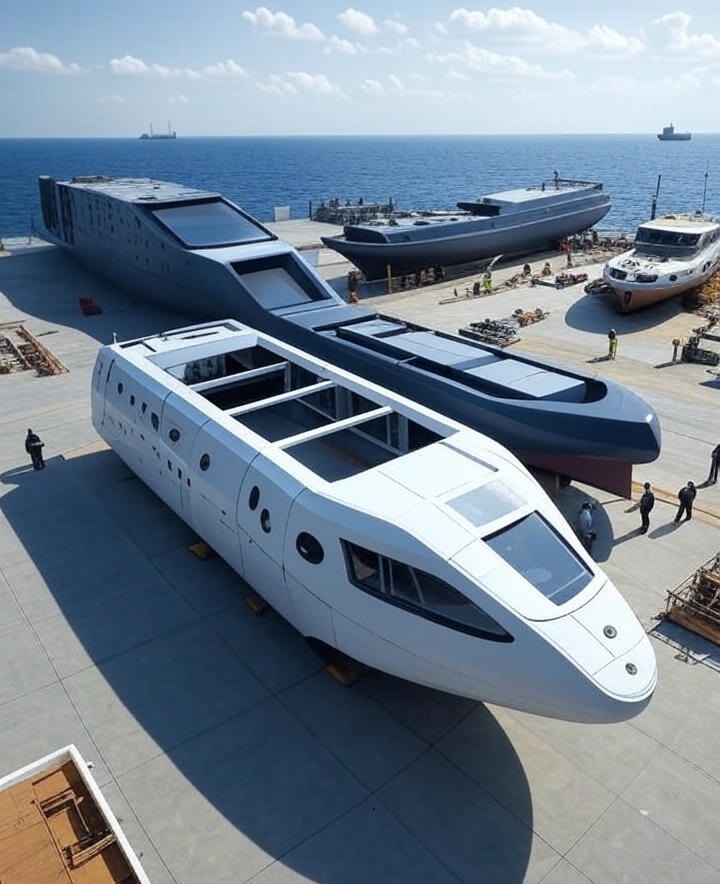
The ocean’s vast expanse is witnessing a seismic shift, a revolution rippling through shipbuilding that’s redefining how we craft vessels. This isn’t just about building ships—it’s about rebirth, renewal, and resilience, all powered by the circular economy. Imagine shipyards where scraps transform into sleek hulls, where waste becomes wealth, and where sustainability sails alongside profitability. This is the dawn of a new maritime era, where recycle and reuse ignite innovation. Let’s plunge into the currents of this transformative wave and explore how it’s reshaping the seas.
The Tide Turns Toward Circularity
For too long, shipbuilding clung to a linear path: extract, build, discard. Steel rusted in scrapyards, composites piled in landfills, and resources dwindled. But the circular economy—a system where materials flow endlessly, reborn rather than retired—is turning the tide. This approach champions recycling, reusing, and rethinking, ensuring ships don’t just sail but sustain. With oceans under pressure and regulations tightening, shipbuilders are embracing this paradigm, crafting vessels that breathe new life into old materials.
The stakes are high. Maritime transport guzzles 300 million tons of fuel yearly, leaving a carbon footprint that demands action. The circular economy offers a lifeline, slashing waste and emissions while fueling economic growth. It’s a win-win that’s captivating shipowners, eco-warriors, and investors alike.
Recycling: From Rust to Resilience
At the core of this revolution lies recycling, the art of resurrecting materials. Steel, the backbone of traditional shipbuilding, often ends its life in junk heaps. But now, advanced recycling techniques melt down these relics, forging new plates and beams with minimal energy loss. High-tech furnaces and alloy recovery systems ensure even the tiniest scraps find purpose, reducing the need for virgin ore.
Composites, once a disposal nightmare due to their complex makeup, are also getting a makeover. Innovative shredding and reprocessing methods break them into reusable fibers and resins. These reborn materials strengthen hulls and decks, proving that yesterday’s waste can be tomorrow’s treasure. Shipyards are buzzing with this alchemy, turning rust into resilience and cutting costs along the way.
Reuse: Breathing New Life into Old Ships
Reuse takes this revolution further, giving aging vessels a second act. Decommissioned ships, once destined for the breaker’s yard, are now dismantled with precision. Components like engines, propellers, and cabins are refurbished, finding homes in new builds or retrofits. This isn’t just salvage—it’s a symphony of sustainability, where every bolt and beam gets a encore.
Take naval fleets, where warships retire after decades of service. Their robust frameworks are repurposed into commercial vessels or training ships, extending their maritime journey. Cruise liners, too, are getting this treatment, with interiors revamped to meet modern tastes. This reuse renaissance cuts production timelines and slashes resource demands, making shipbuilding leaner and greener.
Rethinking Design for a Circular Future
The circular economy isn’t just about recycling and reusing—it’s about redesigning from the keel up. Shipbuilders are crafting vessels with modularity in mind, where parts snap together like a puzzle, easy to replace or recycle. Think hull sections built with detachable panels or engines designed for easy upgrades. This foresight ensures ships adapt over time, reducing waste and boosting longevity.
Materials play a starring role here. Bio-based composites, woven from plant fibers, offer a renewable alternative to petroleum-based resins. Graphene-enhanced coatings, slick and durable, protect hulls while being recyclable. These choices embed sustainability into every plank and panel, aligning with the circular ethos and drawing eco-conscious buyers.
The Green Gains of Circular Shipbuilding
This revolution isn’t just good for the planet—it’s a profit propeller. Lighter, recycled materials cut fuel consumption, saving shipowners millions annually. A cargo vessel rebuilt with circular principles might shed tons of weight, gliding through waves with less drag and lower emissions. Studies suggest these ships can reduce carbon output by up to 30%, a figure that’s music to regulators’ ears.
Economically, the circular model creates jobs—recycling plants, refurbishment hubs, and design labs are springing up. It also mitigates resource scarcity, a growing concern as steel and aluminum prices soar. For shipyards, this is a golden opportunity to lead the charge, attracting contracts from green-focused clients and governments pushing for net-zero seas.
Navigating the Challenges
Yet, this wave isn’t without ripples. Retrofitting old shipyards for circular practices demands hefty investment, a hurdle for smaller players. Sorting and processing diverse materials requires sophisticated tech, and regulatory frameworks lag behind, slow to certify recycled components. Skilled workers, too, need retraining to master these new methods. But the horizon is bright—pilot projects are proving viability, and costs are trending downward as adoption grows.
The Future Sets Sail
Picture a fleet of tomorrow’s ships, their hulls woven from recycled fibers, their engines humming with refurbished power. Envision naval vessels, modular and adaptable, serving decades beyond their prime. Imagine cruise liners, their interiors reborn from past voyages, sailing sustainably into the sunset. This is the revolution on the waves—a circular economy that fuels shipbuilding with innovation and hope.
The maritime world stands at a crossroads. Circular principles are no longer optional; they’re the compass guiding us to a greener, more prosperous future. As shipyards embrace recycle and reuse, they’re not just building ships—they’re building a legacy. The seas are calling, and this revolution is answering with every wave.










